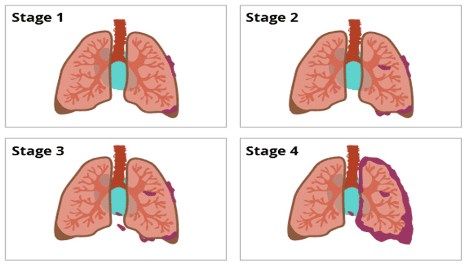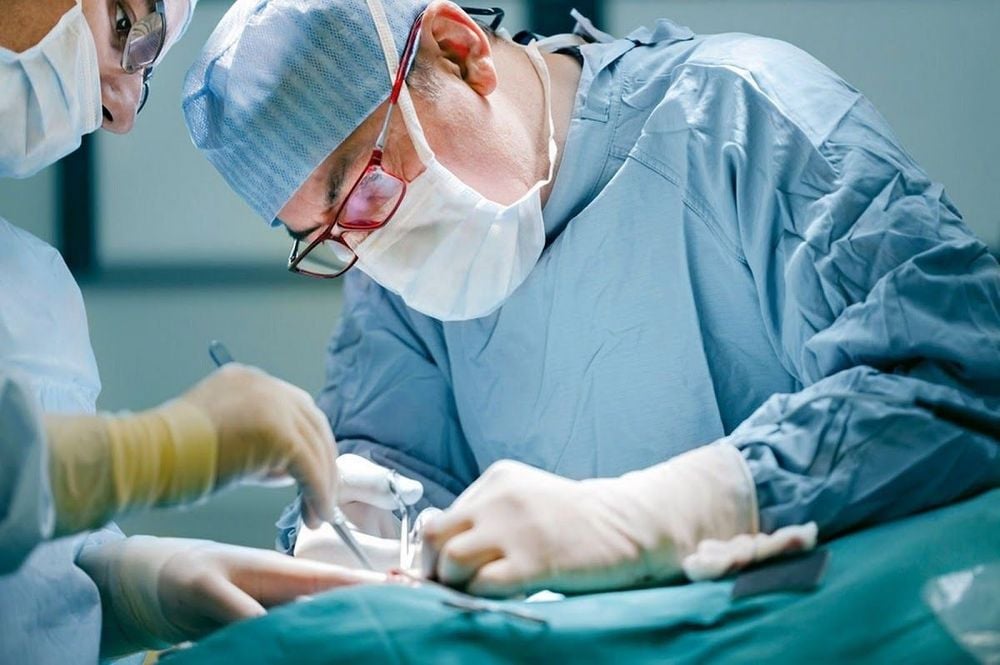This is an automatically translated article.
Stage 3 lung cancer has spread to nearby tissues or distant lymph nodes in the body. In general, lung cancer at this stage is curable, but prognosis and survival depend on many factors, including age, treatments, and overall health.1. Overview of stage 3 phổi lung cancer
Currently, lung cancer is considered one of the leading causes of cancer death. According to information from the Centers for Disease Control and Prevention, lung cancer (especially stage 3 lung cancer) is much more likely to be life-threatening than other cancers. such as prostate cancer, breast cancer and colon cancer.About 40% of people diagnosed with lung cancer usually find out when it is advanced, and 1/3 of them have reached stage 3.
As estimated by the American Cancer Society In the United States, about 85% of lung cancers are non-small cell lung cancer (NSCLC), and only about 10-15% are small cell lung cancer (SCLC). These two types of lung cancer will have different treatments.
In general, stage 3 lung cancer is treatable. However, a patient's prognosis and outlook for survival depends on many factors, including the stage of the cancer, overall health, and treatment plan.
2. Stage 3 . lung cancer classification
When a person is diagnosed with stage 3 lung cancer, it means it has spread from the lungs to nearby tissues or to some distant lymph nodes.Stage 3 lung cancer is usually divided into 3 sub-stages, including stage 3A, 3B and 3C. Both of these stages are divided into subsections based on the location, size of the tumor, and how they affect the lymph nodes.
2.1. Stage 3A Lung Cancer Stage 3A lung cancer is considered locally advanced. At this point, the cancer has spread to lymph nodes on the same side of the chest as the primary lung tumor, but it has not yet spread to distant organs in the body.
The places where lung cancer is most likely to metastasize, include: main bronchus, chest wall, lung lining, membrane around the heart and diaphragm. It can even invade the blood vessels of the heart, esophagus, trachea, rib cage, spine, nerves that supply the larynx, and the carina (where the trachea joins the bronchi).
2.2. Stage 3B Lung Cancer Stage 3B lung cancer is a more advanced stage. The disease has spread to lymph nodes above the collarbone or to nodes on the opposite side of the chest from the site of the primary lung tumor.
2.3. Stage 3C Lung cancer Stage 3 C lung cancer has spread to part or all of the chest wall, its inner lining, the sac surrounding the heart, and the phrenic nerve.
Lung cancer also reaches stage 3C when 2 or more separate tumor nodules in the same lobe have spread to nearby lymph nodes, but the cancer has not spread to distant parts of the body .
Like stage 3A, stage 3B and 3C lung cancer may have spread to other chest structures. In addition, part or all of the lung may collapse or become inflamed.

Ung thư phổi giai đoạn 3 có khả năng đe dọa đến tính mạng người bệnh cao
3. Common symptoms of stage 3 lung cancer
Lung cancer in the early stages often does not show obvious signs and symptoms of the disease. In some cases, the patient may have noticeable symptoms such as: New cough, persistent or persistent cough, change in cough pattern (more frequent, deeper, discharge of blood or substance). mucus).For stage 3 lung cancer, the patient will have the following symptoms:
Shortness of breath, shortness of breath Wheezing Pain in the chest area Unexplained weight loss Voice becomes hoarse Bone pain (often painful) in the back and the pain is stronger at night) Headache.
4. How to treat stage 3 lung cancer
Treatment or cure for stage 3 lung cancer usually begins with surgery to remove as much of the tumor as possible, followed by chemotherapy and radiation. However, surgery alone is not usually indicated for stage 3B.Your doctor may recommend that patients with stage 3 lung cancer have chemotherapy or radiation as a first course of treatment if surgery to remove the cancer is not possible.
According to the National Cancer Institute, when treating stage 3 lung cancer, specifically 3B, with radiation therapy and chemotherapy (concurrently or sequentially) can significantly improve survival rates for the disease. core.
In general, stage 3 lung cancer is treatable, but the effectiveness of treatment depends on the patient's ability to respond to treatments. Overall health and age are important factors in helping doctors assess a patient's response to stage 3 lung cancer treatment.
You should talk to your doctor about any questions or concerns you may have. Questions about treatment options for stage 3 lung cancer . Your doctor will help you determine available options based on your stage, symptoms, and other lifestyle factors.
In addition, clinical trials may also offer a chance to cure stage 3 lung cancer with a new method. While these new treatments may not cure the cancer, they have the potential to significantly reduce symptoms and prolong a patient's life.

Điều trị ung thư phổi giai đoạn 3 thường bắt đầu bằng phương pháp phẫu thuật
5. Prognosis and survival rates of stage 3 phổi lung cancer
Many people wonder how long they can live with stage 3 lung cancer? In fact, the 5-year survival rate from the first diagnosis of stage 3 lung cancer patients can be broken down by the specific cancer stage at the time of diagnosis.According to information from the American Cancer Society, the 5-year survival rate for stage 3A non-small cell lung cancer (NSCLC) is about 36%. For stage 3B lung cancer, the survival rate is 26% and 3C is 1%.
For early detection and timely treatment to avoid unfortunate things happening. In addition to regular health checks, screening and early treatment of lung cancer is very important to help prevent lung cancer. Currently, at the Vinmec International General Hospital system, the package "Screening and early detection of lung cancer" is being implemented with many advantages:
A team of highly qualified and experienced doctors. Comprehensive professional cooperation with domestic and international hospitals: Singapore, Japan, USA, .. Comprehensive treatment and care, multi-specialty coordination towards individualizing each patient. Having a full range of specialized facilities for diagnosis and staging before treatment: Endoscopy, CT scan, PET-CT scan, MRI, histopathological diagnosis, gene-cell testing, .. There are a full range of mainstream cancer treatment methods: surgery, radiation therapy, chemotherapy, stem cell transplant...
Please dial HOTLINE for more information or register for an appointment HERE. Download MyVinmec app to make appointments faster and to manage your bookings easily.
Reference source: healthline.com












